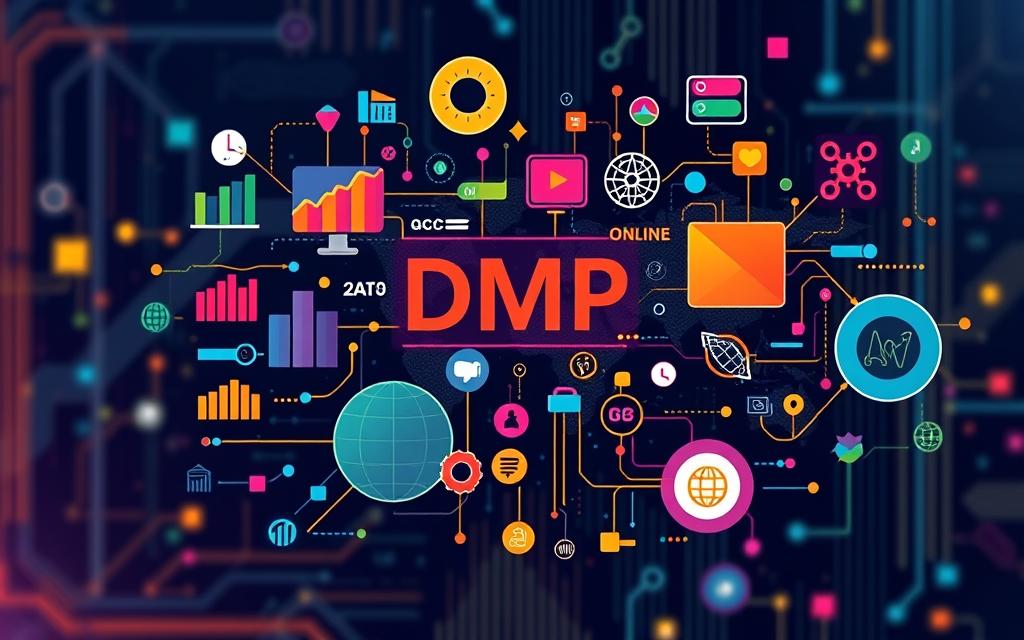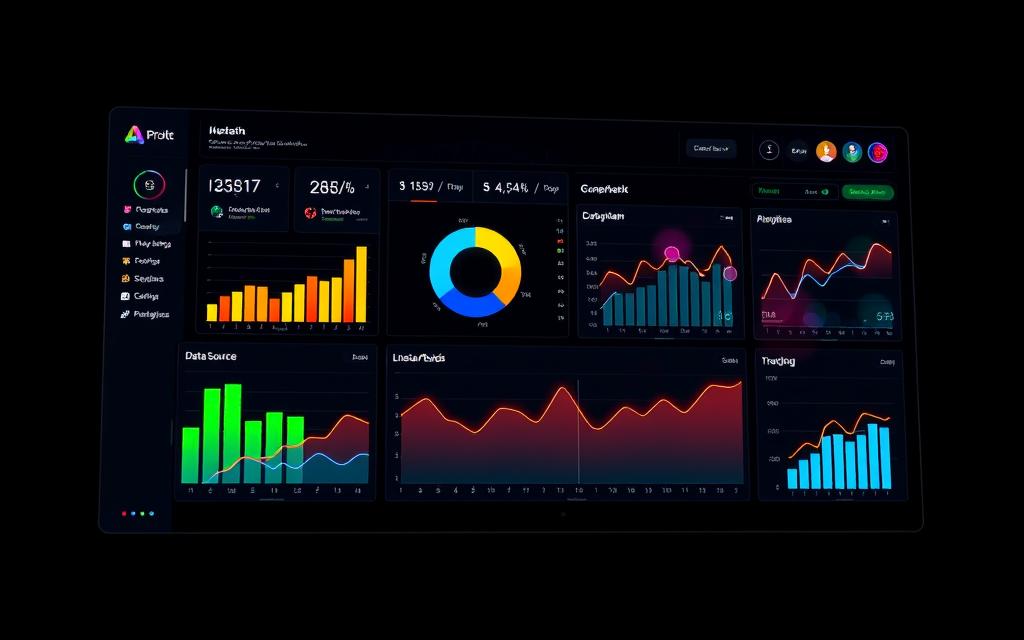Data Management Platforms (DMPs): Your Data Ally
Did you know there are about 5.18 billion internet users worldwide as of April 2023? This is 64.6% of the global population. Marketers face a huge data challenge today. Data Management Platforms (DMPs) are key to handling this data.
DMPs are essential for marketers. They bring together data from different sources. This helps avoid data silos, where data is scattered across tools.
They collect, store, and analyze data from various sources. This lets companies segment their audience and create custom marketing plans. With deep data insights, advertisers can improve their targeting and media buying.
Using DMPs maximizes marketing ROI and meets data privacy rules. They help businesses keep their digital ads up to date and effective.
Key Takeaways
- DMPs help marketers navigate complex data landscapes by centralizing data from multiple sources.
- First-party data, sourced directly from customers, is regarded as the most valuable for targeted marketing efforts.
- Second-party data acquired from partners allows brands to reach new customer groups effectively.
- Third-party data, while less valuable, supplements campaigns with key demographic insights.
- DMPs play a crucial role in audience segmentation, enhancing personalized marketing campaigns.
- Integration with other marketing technology solutions is facilitated by APIs for seamless data exchange.
- Maintaining compliance with data privacy regulations is a key benefit of utilizing DMPs.
Understanding Data Management Platforms (DMPs)
In today’s world, nearly 1.7 billion people use the internet every day. Businesses see a huge opportunity in this vast amount of data. Data Management Platforms (DMPs) help brands make the most of it. They are software tools that bring together data from many sources, like mobile apps and CRM systems.
DMPs are great at customer data integration. They work well with both first-party and third-party data. This lets marketers get deeper audience insights to shape their strategies. First-party data comes directly from users, while second-party data is shared between companies. Third-party data is used for targeting, but raises privacy concerns.
DMPs solve the problem of data silos. They help marketers use all data to improve their strategies. By making data uniform, they make it easier to segment and target ads. This leads to better campaign results.
DMPs also help create and activate audiences. Advertisers can use these tools to make their online ads more effective. Over the last ten years, DMPs have become key in digital marketing, supporting sales strategies focused on customers.
For marketers wanting to do better in a data-driven world, knowing about DMPs is crucial. To find more tools to boost your digital marketing, check out this guide on digital marketing platforms.
The Importance of Data Integration in Marketing
In today’s fast-paced world, customer data integration is key to winning in marketing. Companies use data management platforms (DMPs) to bring together data from different places. This gives marketers a full picture of how customers behave.
With this info, they can make marketing that really speaks to people. It’s all about understanding what customers want and giving it to them.
Using data governance tools is crucial for keeping data clean and following the rules. With privacy laws getting tougher, good governance helps companies stay on the right side of the law. It also gives them valuable insights.
DMPs make it easy to get to the data you need. This means no more waiting for information that’s stuck in silos. It’s a big win for marketing.
Thanks to marketing technology solutions like DMPs, finding the right info is much faster. This means marketers can make decisions quicker. They can also see how their campaigns are doing and make changes fast.
With all the different kinds of data out there, companies can really tailor their messages. DMPs help track how people move between devices and channels. This is super important for understanding customer behavior.
In the end, using customer data makes marketing better and strengthens the bond between brands and their audience. By using a mix of data sources, companies can be quick to adapt to what customers want. For more on how data is used in marketing, check out this resource.
Types of Data Collected by DMPs
Data Management Platforms (DMPs) collect different types of data to boost marketing. Knowing these types helps businesses better understand their audience. They focus on first-party, second-party, and third-party data. Each type offers unique insights for making better decisions.
First-Party Data
First-party data comes from users who interact with a brand. It includes website analytics and customer data. This data helps businesses tailor experiences for their customers, knowing their likes and behaviors.
Using first-party data makes marketing more accurate. It lets brands connect better with their audience.
Second-Party Data
Second-party data comes from partnerships between companies. One company gets to use the other’s first-party data. This is great for reaching new audiences without direct competition.
For example, a car rental service might share data with an airline. This way, both can target new customers more effectively. Such partnerships improve audience understanding and engagement.
Third-Party Data
Third-party data comes from outside sources, like data aggregators. It’s often bought to improve targeting. While it raises privacy concerns, it’s useful for better audience segmentation.
Using third-party data helps businesses find and reach new customers. It makes marketing efforts more accurate and effective.

Data Management Platforms (DMPs) and Audience Segmentation
Data management platforms (DMPs) help reveal detailed audience insights. They collect data from various sources. This lets marketers segment their audiences by demographics, interests, and online behavior.
Using advanced data analytics, businesses can focus on segments that connect with their marketing. This leads to better engagement and higher conversion rates.
Advertisers use DMPs to create detailed user profiles. This helps them craft targeted campaigns for each segment. Personalized marketing makes a stronger connection with potential customers.
Effective audience segmentation means the right message reaches the right person at the right time.
Businesses can use audience segmentation tools to manage their audience segments well. For example, Google Ad Manager 360 works with DMPs. It makes managing segments easy.
Just link the DMP and Ad Manager with an Audience Solutions link ID. This way, publishers can update their segments in Ad Manager.
While DMPs offer many benefits, marketers must handle data carefully. The quality of data is key for good audience analysis. Understanding data ownership, privacy, and cookie technology helps businesses manage segmentation well.
Benefits of Using a DMP for Digital Advertising
Using a data management platform (DMP) brings big benefits to digital ads. These tools help marketers make their strategies better and more precise.
Improved Targeting
DMPs make it easier to target the right people with ads. They use different types of data to place ads where they’ll be seen best. This way, ads reach the right people at the right time, making campaigns more effective.
Real-Time Data Processing
DMPs process data as it happens, giving marketers fast insights. They can change their ads quickly to keep people interested. This quick action helps ads perform better on different platforms.
How DMPs Work: Data Collection and Analysis
Data Management Platforms (DMPs) are key in today’s data world. They help companies by organizing data from many sources. This makes it easier to understand and use the data.
DMPs collect data in different ways, like using JavaScript tags and APIs. They gather data from various sources, helping businesses know their audience better. This knowledge improves marketing efforts.

Normalization is a big part of what DMPs do. They clean up data and make it useful for marketing. This way, businesses can target their ads better.
Good data collection and cleaning lead to better marketing. DMPs help marketers understand their audience. This lets them create ads that really work.
Cross-Device Targeting with DMPs
Cross-device targeting is a key feature of data management platforms (DMPs). It lets marketers reach users on different devices like smartphones, desktops, and TVs. DMPs track and analyze user actions on these platforms, giving a deeper look into how people behave.
DMPs gather data from various sources to build detailed customer profiles. This helps advertisers send messages that are relevant and consistent, no matter where people see them. Good cross-device targeting makes the customer experience better, leading to more loyalty and retention.
Investing in DMPs, like those from LiveRamp, shows their value in marketing. Although it costs a lot, the benefits can make advertising more effective and increase ROI. More companies are using DMPs to get better insights into their audiences and stay competitive.
Integrating DMPs with Other Marketing Technology Solutions
Data Management Platforms (DMPs) work better when paired with other marketing tech. Combining DMPs with customer data platforms (CDPs), demand-side platforms (DSPs), and email tools creates a strong marketing system. This setup makes data sharing smoother and boosts targeted marketing.
Marketers get better insights and campaigns thanks to data flowing easily between platforms. DMPs help manage different types of data. This lets marketers create detailed profiles and adjust their plans based on trends. Adding data governance tools ensures marketing stays within privacy laws.
With martech growing fast, companies have many options to improve their campaigns. DMPs are key for medium and big companies, linking with many platforms to automate marketing. Small startups can move from basic analytics to DMPs, making their ads more effective and driving more sales.
Using DMPs with other marketing tech leads to better campaign results. It helps brands understand their audience better, leading to more personalized experiences and loyal customers. Marketers can see higher engagement and a good return on their marketing investments.
Conclusion
Data Management Platforms (DMPs) are key for modern marketers. They help unlock the power of data-driven strategies. DMPs collect, process, and analyze lots of data from different sources.
This leads to detailed audience segments. These segments help create personalized ad experiences. Using DMPs in digital advertising platforms improves targeting and campaign success.
Marketers can then connect with their audience more effectively. This ensures their messages hit the mark.
As the digital world grows, using DMPs with other marketing tech is crucial. This mix enriches data and boosts campaign performance. It uses real-time insights and automated bidding.
Marketers who use DMPs with DSPs and SSPs get the most out of their ad spend. They ensure their ads reach the right people.
Using Data Management Platforms can lead to new and better advertising strategies. It gives marketers a competitive edge. They can drive higher engagement and get better returns on investment in the digital world.
FAQ
What are Data Management Platforms (DMPs)?
Data Management Platforms (DMPs) are tools that collect and organize data. They help marketers understand audience behavior. This way, they can target their ads better and improve their campaigns.
How do DMPs support audience segmentation?
DMPs group people based on who they are and what they like. This lets marketers send out ads that really speak to their audience. It makes ads more effective and engaging.
What types of data do DMPs collect?
DMPs gather three kinds of data. First-party data comes from users directly. Second-party data comes from partners. And third-party data is from other sources. Each type helps make ads more targeted.
Why is data integration important for marketing?
Integrating data gives a clear view of all the information. It helps marketers understand how users behave and tailor their ads. This makes marketing more effective and efficient.
What benefits do DMPs offer for digital advertising?
DMPs help target ads better and process data in real-time. This means marketers can adjust their strategies quickly. It helps them reach the right people at the right time.
How do DMPs facilitate cross-device targeting?
DMPs track how people use different devices. They create detailed profiles of users. This lets marketers send consistent messages, no matter the device.
Can DMPs integrate with other marketing technology solutions?
Yes, DMPs work with other marketing tools like CDPs and DSPs. This makes managing data and campaigns more efficient. It helps marketers work better together.
How do DMPs enhance data governance?
DMPs help manage data better by keeping it accurate and secure. They also help marketers follow privacy rules. This way, they can use data to improve their marketing.







